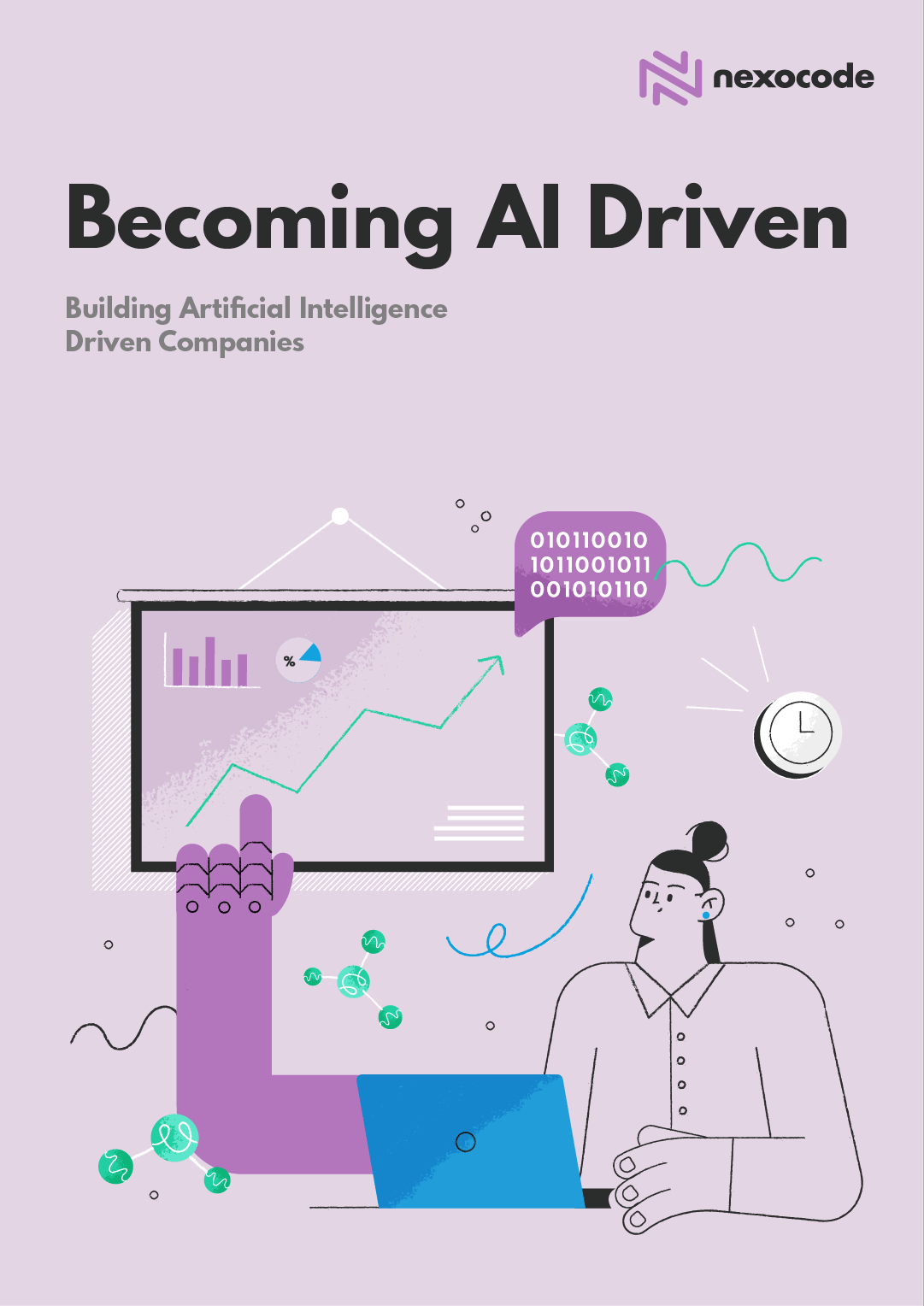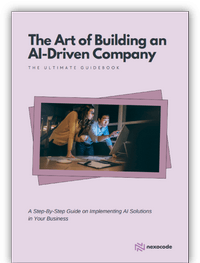Artificial Intelligence is taking over almost every industry – companies want to experiment with the possibilities of AI to bring additional value to their product or service. Data from Accenture’s research says that in the upcoming year, more than 65% of companies plan to invest in AI – it’s obvious considering the fact that in some industries, AI will help boost revenue by 30%.
But it might be very challenging to get a predictable and positive ROI from AI projects. Research by Capgemini says that only 27% of data-related projects can be considered successful, and up to 85% of AI projects fall without bringing the expected value.
That’s why in this article, we would like to make it easier for you and to present the battle-tested list of activities and theories which will help you to get ROI from your AI projects.
What is AI? How to understand the ROI of artificial intelligence projects?
In the beginning, it might be essential to talk about some definitions because many companies consider every data-based project as an
AI solution, but this is not working this way. Definition provided by Oxford dictionary explains that AI is “the theory and development of computer systems able to perform tasks normally requiring human intelligence, such as visual perception, speech recognition, decision-making, and translation between languages.” Those activities can be used in many ways to improve multiple areas in almost every company – that’s why business leaders are so excited about AI initiatives. But on the other side, as applying AI solutions at the production level is still relatively new and full of experiments, it might be hard to have a clear vision of ROI.
ROI, or Return on Investment, measures the gain/loss generated by an investment concerning its initial cost. ROI allows us to assess the efficiency and profitability of expenditure and is often used to
influence financial decisions, compare a company’s profitability, and analyze investments. Return of Investments in Artificial Intelligence projects can be seen from many different angles, not only as a pure profit in cash. As the survey made by Deloitte says, the top areas where data science projects deliver value include:
- customer experience and service
- streamlining processes with automation
- IT operations and infrastructure
- planning and decision making
- building insights and predictions
In what ways can a company benefit from the AI implementation? The same report says that usually, data science implementations deliver value in:
- higher productivity (for example, by removing repetitive tasks),
- lower operation costs,
- increased customer satisfaction and retention,
- improved employee engagement,
- improved profitability,
- resilience in changing environments (predictive and prescriptive data analytics)
- new products and services.
As previously said, the average expected ROI can reach up to 30% in upcoming years. Still, the average ROI of AI investments is 4,3% (in the case of leaders of the market) and 0,2% in organizations that just started their first AI project. The average time of payback is from 1,2 to 1,6 years.
How to turn AI into a profitable investment?
Although planning the ROI from AI might be challenging, as there is a lot of factors, changes, and experiments, there is a set of rules which can be very useful in predictions:
1. Define needs, business value and set up the goals
Every business has its own characteristics and needs. That’s why the implementation of machine learning should be tailor-made. Find your pain points and define a business case for AI at your organization. You should know what the goal of this implementation is and what your KPIs will be. Also, a method of measurement should be precise.
2. Plan the funding
Like every investment, AI needs funds for implementation, monitoring, and optimization. It would help if you predicted all the costs that your project can take in the time – like costs of tools, technology, team, etc. This is one of the most important factors because as much you will need to invest as high your return should be
3. Verify the skills of your team
Usually, AI applications are more complex, which means you might need additional skills in your team. Your employees might need additional training, the development of new skills, or simply new team members. McKinsey’s study says that more than 30% of employees might need to learn some new skills or change their job in upcoming years.
It is crucial to create a culture of self-development in the company from the very start. If you don’t have an IT department experienced in building and deploying machine learning models, you should consider outsourcing. Think about hiring a team with data scientists, ML experts,
MLOps, and managers experienced with AI tech.
4. Plan your data strategy
The more data you will get from your AI product, the better your ML algorithms will be, and you will have more possibilities to optimize it. More than 52% of people surveyed by The Pistoia Alliance stated that the lack of data is their biggest fear in developing AI systems. Without the possibility of taking the
data from your AI project, you will not measure ROI.
5. Choose the right technology
AI implementation should always be an answer to the existing problem. If you know what your issues are, you can verify different technologies available on the market. This will give you an overview and check if the development of these solutions with other technologies will not be a better option.
6. Test it before scaling
You might need to verify your ideas before final development. This approach will help you reduce costs – for example, when the technology will fail.
How to reduce the risk of investment in machine learning?
There are ways to reduce the risk of not getting value from AI-based applications. Both are based on a deep understanding of the needs of the projects and the possibilities of current AI technologies. Read more about it
here.
AI Design Sprint
It is our own approach to AI development. AI Design Sprint is a hands-on experience where, together, we identify potential AI use-cases for your business and explore the business opportunities available to you. We have created a set of tools for each step of the design-thinking process to help our clients look deeper into their data and processes and turn AI into social, user, and business value. Within just two days, the client team, supported by our AI Engineers and Design Facilitators, learns and understands the power of emerging technologies, spots AI opportunities, and creates new ideas and visions. You can find more detailed information on the
AI Design Sprint here.
AI Proof of Concept
Creating the proof of concept can be a perfect way to demonstrate the business value for all the stakeholders and decision-makers. In this approach, you don’t need to develop the whole project but verify your idea and the idea possibilities on a tight budget and in a short time. It might also have a limited amount of features, but enough to prove that the final project will work and bring the expected value. For AI development, it is crucial to embrace the culture of the iterative experiments. Each experiment focuses on evaluating data haves and the creation of an AI model. AI Proof of Concept helps consider the benchmarks and the possibilities of a full-grown model working with new data at scale. It lets you decide at an early stage whether AI on production would give you the desired value and is worth the investment.
How to measure the ROI of AI?
It might be very challenging to develop internal standards, goals, and KPIs inside your AI project. We want to put your focus on a few crucial factors:
Costs – as previously said, building a
custom AI system is almost always a significant investment. You need to invest your resources to bring you profit. High costs of development will influence your ROI. Don’t forget about including the costs of team, licenses, security, platforms, algorithm, model design, data, etc.
Savings – this might be one of the most important ways to measure the ROI of AI. Sometimes the AI project can bring you profit in reduced costs of your company’s daily activities instead of a pure income in cash.
Soft profits – not only profits or savings can be the benefit of a machine learning project. With the support of AI, you can improve your company in countless areas like, for example, productivity, product quality, customer satisfaction, and this can lead your company to increased profits later.
Goals and KPIs – try to predict the purpose of your project, especially from the financial perspective. We suggest you think about the point in time when your investment in the AI project will be equal to your benefits from it.
Future profits – very often, the implementation of AI in the company generates a new revenue stream, so you should also consider them before predicting the ROI of AI investment.
Summary
For sure, Artificial Intelligence will influence our businesses in upcoming years. Companies want to invest their cash in AI development to bring revenue for them or make some areas of their work much better. But there is no guarantee that a custom AI software will get this expected value or the total cost will not be too high to handle. That is why a detailed planning phase and an iterative approach are crucial in every project with AI. Only in this way will you be able to predict the cost, income, and break-even points of your development.
To move forward, we should seek for business people to pay closer attention to understanding data science and AI, getting more active in the current, quite a lively AI discussion. Their contribution in areas like refined commercial and business models and tactics can help companies gain more competitiveness from AI. A more multifaceted conversation on the subject would help all of us address AI as a multidisciplinary question outside the silo of software development and data science. Increasing interest from C-level executives and managers in AI capabilities will result in better dialogue around delivering value and commercial aspects of AI and the true success of future AI endeavors.
References
Financial Analysis Dictionary | InvestingAnswers







